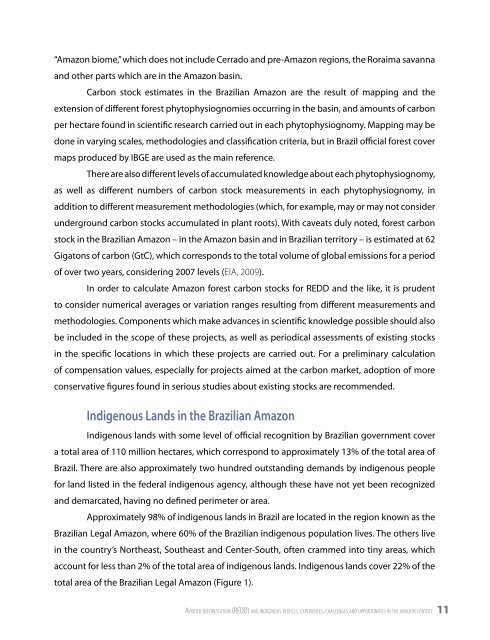Avoided Deforestation (REDD) and Indigenous ... - Amazon Fund
Avoided Deforestation (REDD) and Indigenous ... - Amazon Fund
Avoided Deforestation (REDD) and Indigenous ... - Amazon Fund
Create successful ePaper yourself
Turn your PDF publications into a flip-book with our unique Google optimized e-Paper software.
“<strong>Amazon</strong> biome,” which does not include Cerrado <strong>and</strong> pre-<strong>Amazon</strong> regions, the Roraima savanna<br />
<strong>and</strong> other parts which are in the <strong>Amazon</strong> basin.<br />
Carbon stock estimates in the Brazilian <strong>Amazon</strong> are the result of mapping <strong>and</strong> the<br />
extension of different forest phytophysiognomies occurring in the basin, <strong>and</strong> amounts of carbon<br />
per hectare found in scientific research carried out in each phytophysiognomy. Mapping may be<br />
done in varying scales, methodologies <strong>and</strong> classification criteria, but in Brazil official forest cover<br />
maps produced by IBGE are used as the main reference.<br />
There are also different levels of accumulated knowledge about each phytophysiognomy,<br />
as well as different numbers of carbon stock measurements in each phytophysiognomy, in<br />
addition to different measurement methodologies (which, for example, may or may not consider<br />
underground carbon stocks accumulated in plant roots). With caveats duly noted, forest carbon<br />
stock in the Brazilian <strong>Amazon</strong> – in the <strong>Amazon</strong> basin <strong>and</strong> in Brazilian territory – is estimated at 62<br />
Gigatons of carbon (GtC), which corresponds to the total volume of global emissions for a period<br />
of over two years, considering 2007 levels (EIA, 2009).<br />
In order to calculate <strong>Amazon</strong> forest carbon stocks for <strong>REDD</strong> <strong>and</strong> the like, it is prudent<br />
to consider numerical averages or variation ranges resulting from different measurements <strong>and</strong><br />
methodologies. Components which make advances in scientific knowledge possible should also<br />
be included in the scope of these projects, as well as periodical assessments of existing stocks<br />
in the specific locations in which these projects are carried out. For a preliminary calculation<br />
of compensation values, especially for projects aimed at the carbon market, adoption of more<br />
conservative figures found in serious studies about existing stocks are recommended.<br />
<strong>Indigenous</strong> L<strong>and</strong>s in the Brazilian <strong>Amazon</strong><br />
<strong>Indigenous</strong> l<strong>and</strong>s with some level of official recognition by Brazilian government cover<br />
a total area of 110 million hectares, which correspond to approximately 13% of the total area of<br />
Brazil. There are also approximately two hundred outst<strong>and</strong>ing dem<strong>and</strong>s by indigenous people<br />
for l<strong>and</strong> listed in the federal indigenous agency, although these have not yet been recognized<br />
<strong>and</strong> demarcated, having no defined perimeter or area.<br />
Approximately 98% of indigenous l<strong>and</strong>s in Brazil are located in the region known as the<br />
Brazilian Legal <strong>Amazon</strong>, where 60% of the Brazilian indigenous population lives. The others live<br />
in the country’s Northeast, Southeast <strong>and</strong> Center-South, often crammed into tiny areas, which<br />
account for less than 2% of the total area of indigenous l<strong>and</strong>s. <strong>Indigenous</strong> l<strong>and</strong>s cover 22% of the<br />
total area of the Brazilian Legal <strong>Amazon</strong> (Figure 1).<br />
Av o i d e d d e f o re s t A t i o n (redd) A n d i n d i g e n o u s p e o p l e s: experiences, chAllenges A n d o p p o r t u n i t i e s in t h e A m A zo n c o n t e x t 11
















